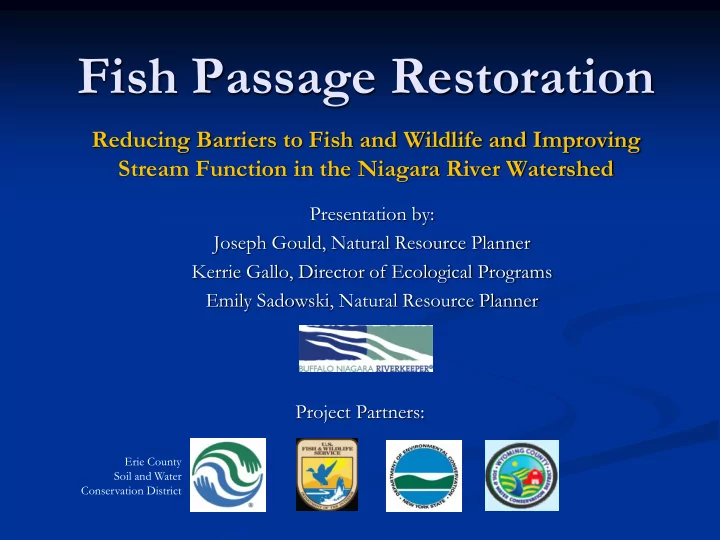

Fish Passage Restoration Reducing Barriers to Fish and Wildlife and Improving Stream Function in the Niagara River Watershed Presentation by: Joseph Gould, Natural Resource Planner Kerrie Gallo, Director of Ecological Programs Emily Sadowski, Natural Resource Planner Project Partners: Erie County Soil and Water Conservation District
Agenda Provide watershed context based on Niagara River Watershed Habitat Conservation Strategy Fish barrier assessment work Stream crossings Common problems Stream crossing guidelines Stream Classifications Misclassification of Streams Permit requirements Questions & discussion
Watershed Context
Ecosystem-based Framework: Provide a scientifically driven, stakeholder influenced blueprint for ecosystem- based planning and habitat conservation in the Niagara River Watershed. Project Details: • 3 year project-completed in August 2014 • 903,305 acres • Portions of 4 counties -Erie (75.6%) -Niagara (46.9%) -Genesee (52.5%) -Wyoming (16.2%) • 3,250 miles of streams
Priority Recommendations Adopt and implement ecology-based headwater forest protection/ plans/ policies/ practices -Headwater streams shape entire downstream systems - “From a watershed perspective, planting vegetation along smaller systems will produce greater aquatic habitat benefits than planting along higher-order rivers…” ( How Much Habitat Is Enough , Environment Canada)
Key Finding #3 Lack of sufficient …an interconnected network of regional Living waterways, wetlands, woodlands, Infrastructure wildlife habitats, and other natural areas of significance. Network/ Components/Functions: Protections Riparian Buffers/Filtration Wetlands/Filtration & Storage Floodplains/Connectivity & Flood Mitigation Natural Springs/Recharge Headwater Forests/Drinking Water Wildlife Corridors/Biodiversity
Niagara River Watershed – Land Use • Wild, Conservation & Public Park Uses make up <5% of total land use acreage • Long-term protection of water resources and living infrastructure will require a much greater investment in protective uses and policies
Habitat Focused Watershed Goals Restore connectivity Restore hydrologic function Protect/restore unique habitats Restore quality
Fish Barrier Assessment
4,000+ Stream Crossings (culverts) in the Niagara Watershed
Stream Crossing Assessments FishXing Model was used to analyze data collected and determine whether the culvert is passable or not
Trout Presence by Species This map represents the general geographic extent of trout by sub-species in the Niagara River Watershed. Some seasonal spawning and stocking is not represented on this map. This map is based on NYS DEC historical records that were digitized as well as work completed by U.S. FWS & Buffalo Niagara Riverkeeper in 2014 and 2015 field seasons.
https://www.streamcontinuity.org/cdb2/naacc_search_crossing.cfm?sp=1
Stream Crossing Problems and Guidelines
How are Stream Crossings Barriers to Fish? Unnatural channels with shallow or high flow cause fish to reach their exhaustion rate. Water velocities higher than 4 feet per second (CFS) will begin to impede passage for some species. Without adequate natural stream bed material fish do not have refuge to rest and feed. On average, barriers higher than 16 inches (40cm) are above the maximum jump height of an adult Brook Trout.
Common Problems Undersized Perched Culvert Crossing Misaligned High Shallow Crossing Gradient Crossing
Suggested Guidelines
Action Steps Highway departments should consider stream crossing guidelines during infrastructure replacement projects Riverkeeper has identified high priority culverts targeted for replacement and stream restoration projects
Stream Classification and Permit Problems and Requirements
Stream Classification and Permits Special permits are required for any activity occurring within a stream designated as T or TS. However, these designations have been found inconsistent with the currently known locations of trout populations. (T) trout populations (TS) trout spawning
Stream Classification & Generalized Range of Trout in the Niagara River Watershed (Note: this does not represent seasonal spawning or stocking)
Action Steps If you are working in a class A or B stream or a C stream with a T (trout present) or TS (trout spawning) designation please conform to special permit requirements Contact NYS DEC Region 9 Permits Office for details regarding special permit requirements If you believe you are working in a stream that has trout but is not classified properly please contact NYSDEC Region 9 Fisheries Office Region 9 Bureau of Fisheries Region 9 Permit Administrator www.dec.ny.gov/outdoor/32616.html www.dec.ny.gov/about/39381.htm Scott Cornett David Denk 182 East Union Street Email: dep.r9@dec.ny.gov Allegany, N.Y. 14706 Office: 716-851-7165 Office: 716-372-0645 Fax: 716-851-7168
Key Takeaways Headwater conservation is critically important for the health of the Niagara River Watershed Utilizing the stream crossing guidelines when designing and replacing culverts will allow for the natural passage of fish and wildlife Understanding the geographic extent of trout in our watershed beyond the classified streams will help ensure proper installation techniques and protection of our fisheries resources
Additional Resources NYS Department of Environmental Conservation. 2011. Stream Crossings. http://www.dec.ny.gov/docs/permits_ej_operations_pdf/streamcrossing.pdf. University of Massachusetts Amherst. 2004. River and Stream Continuity Project. www.streamcontinuity.org Eastern Brook Trout Joint Venture. 2006. Eastern Brook Trout : Status and threats. Prepared by Trout Unlimited, Arlington, VA, for EBTJV36 pp. Singler, A. and B. Graber. 2005. Massachusetts Stream Crossings Handbook. Massachusetts Riverways Program, Massachusetts Department of Fish and Game
Thank you Joseph Gould, Natural Resource Planner jgould@bnriverkeeper.org (716) 852-7483 ext. 27
Recommend
More recommend